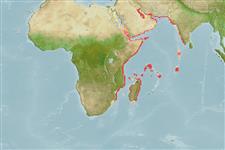Common names from other countries
Classification / Names / Names
ماع يماسا | فدارتم | Catalog of Fishes (gen., sp.) | ITIS | CoL | WoRMS
Environment: milieu / climate zone / depth range / distribution range
يسانش موب
; قمع تارييغت 0 - 24 m (Ref. 107695). Tropical
Western Indian Ocean.
Length at first maturity / Size / Weight / نس
Maturity: Lm ? range ? - ? cm
Minimum depth from Ref. 1726. Intertidal to shallow subtidal. Found under medium-sized granite rocks or dead coral slabs, slightly buried in coarse sand (Ref. 1726). Most chitons are microphagous feeders that consume fine algae and other organisms they scrape via their radula (Ref. 833).
Life cycle and mating behavior
غولب | لثم دیلوت | یزیر مخت | اه مخت | Fecundity | )ورال ( دازوت
Members of the class Polyplacophora are mostly gonochoric. Life cycle: Eggs hatch into lecitotrophic planktonic trocophore larvae (no veliger stage) which later metamorphose and settle on the bottom as young adults.
یلصا ذخآم
عجارم | هدننك گنهامه | ناراكمه
Dell'Angelo, B., A. Bonfitto, M. Taviani and B. Sabelli. 2003. (Ref. 703)
NCUI زمرق تسرهف رد تيعضو (Ref. 130435)
ستياس رظن زا تيعضو (Ref. 108899)
Not Evaluated
Not Evaluated
اه ناسنا یارب رطخ
Harmless
یناسنا هدافتسا
| FishSource |
اهرازبا
رتشيب تاعالطا
Age/Size
دشر
نزو - لوط
لوط - لوط
يسانش تخير
)ورال ( دازوت
يناوارف
يتنرتنيا عبانم
Estimates based on models
Preferred temperature
(Ref.
115969): 26.2 - 29, mean 27.5 (based on 543 cells).
تميق هقبط
Unknown.
